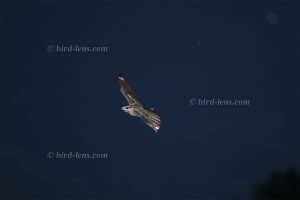 When the sun has set and dusk turns to darkness, a discreet purring is heard often over the heath in Brandenburg´s landscape south of Berlin. The rhythmic purr of the Eurasian or European Nightjar (Caprimulgus europaeus) is increasing in volume in the background. The time lags between the purring of the Nightjar become shorter more and more. Finally, the male begins to patrol its territory. Slow, excessive wing beats enhance the impression of a relevant actor in the night theatre. It is beautiful to admire the white spots on the tail edge and the primaries. Only a few moment, this event takes place; then the Nightjar has disappeared already in the adjacent ash grove.
When the sun has set and dusk turns to darkness, a discreet purring is heard often over the heath in Brandenburg´s landscape south of Berlin. The rhythmic purr of the Eurasian or European Nightjar (Caprimulgus europaeus) is increasing in volume in the background. The time lags between the purring of the Nightjar become shorter more and more. Finally, the male begins to patrol its territory. Slow, excessive wing beats enhance the impression of a relevant actor in the night theatre. It is beautiful to admire the white spots on the tail edge and the primaries. Only a few moment, this event takes place; then the Nightjar has disappeared already in the adjacent ash grove.
Like all members of the family, the European Nightjar (Caprimulgus europaeus) is an almost exclusively aerial feeder that feed in continuous hawking flight, which may be rather erratic as they pursue their prey. European Nightjars hunts moths, beetles and many other flying insects by sight. Main prey consists of Dung Beetle (Aphodius fimetarius), Pine Tree Lappet Moth (Dendrolimus pini), Silver Y (Autographa gamma) and Lackeys (Malacosoma neustria).
Its nocturnal habits leave it with few competitors apart from bats, and it has been recorded capturing up to 12 food items per minute. During the breeding season, food is delivered to nestlings and fledglings in the form of mashed up insects regurgitated in balls. When the adult visits the nest, a hungry chick reaches up to grab its bill and begs. In response, the adult inserts food into the chick’s mouth or holds it up for the chick to take. The size of item brought to the nest is related to the age of chicks, with wellgrown young being delivered conspicuously large prey items.
On their wintering grounds European Nightjars generally prefer savanna and woodland in Africa. The woodland is composed mainly by miombo (Brachystegia), mopane (Colosphermum mopane) and Acacia woodland, but it can also be found in gardens and parks. It almost exclusively eats flying insects, (Coleoptera, Lepidoptera, Hemiptera, Orthoptera, Hymenoptera), doing most of its foraging at dusk and a few hours before sunrise. It usually hunts from a perch overlooking an open area, such as a cultivated field, occasionally launching into the air to catch an insect before returning to its perch. Sometimes Nightjars are hawking insects attracted to electric lights in urban areas.
It is a sad fact, that the European Nightjar has decreased substantially in many portions of its range, as Nightjars inhabit dry, heat-exposed, open landscapes with a sufficient supply of night flying insects. Landscapes used extensively are becoming really rare in Middle Europe. Reduced grazing of heathlands and pastoral woodlands accelerates vegetational succession, while conversion to cultivation or the growing land usage for renewable power production (like wind turbine parks or solar panel parks) eliminates them altogether. These factors have reduced nightjar numbers and are compounded by catastrophic reductions in the populations of large insects, such as Common Cockchafers (Melolontha melolontha), since the widespread application of pesticides on farmland.
In Germany secondary habitats such as military training areas or disused mining sites have become the last relevant remaining refuges where remarkable population densities still persist. In the eastern states of Mecklenburg-Western Pomerania and Brandenburg you find these areas. These landscapes are characterized by vast heaths, open sandy areas, pine forests and sometimes even shifting dunes. Unfortunately, the former military training areas with sometimes very high, significant population densities show “No Trespassing” – signs. For security reasons large area are not open for the public at all and others you must adhere to the public footpaths or to the access roads to wind turbine parks.
To cope with the growing demand for top shots of the rarer species of the Palearctic Bird-Lens is keen to enrich the range of pictures of birds you can find in the Western Palearctic. Trips to remote places or to common – but underestimated locations as described above – to capture images of rare birds of Western Palearctic were very successful. The nice images you find in the gallery are only a first impression, what you will find in the gallery in the “Picture Shop” very soon. Just give me a message, if bird-lens.com could serve you with an image needed before the new pictures are online.
If you are interested to see the birdlist of Western Palearctic and want to be connected to other successful shootings of birds of the Western Palearctic you will see here more……